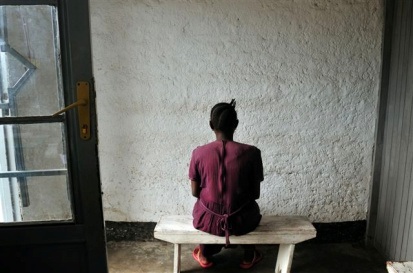Photo of the Week: Legacies of the Congo Civil War
by Elizabeth Hoover / June 25, 2010 / 3 Comments

A pregnant teenager waits for care in a medical facility in North Kivu.
Photo by Lynsey Addario
In Regarding the Pain of Others Susan Sontag writes, “Photographs are a way of making ‘real’ (or ‘more real’) matters that the privileged or the merely safe might prefer to ignore.” But for Sontag, pictures create moral dilemmas when they are separated from context. A photograph of civilian corpses after a bombing, she writes, creates “general abhorrence” for violence—one that can be allayed by simply looking away. It does not, she argues, create a greater understanding of the particular war and therefore does nothing to incite the viewer to act or speak out against what they are seeing.
In essence, viewer becomes voyeur.
Congo/Women, an exhibit of photographs documenting the effects of gender-based violence in the Democratic Republic of the Congo, asks viewers “too look and to learn and then to act,” according to a statement from the exhibit’s website. The exhibit features the work of photographers Lynsey Addario, Marcus Bleasdale, Ron Haviv, and James Nachtwey and is accompanied by video and audio testimony of survivors. It will be on view at the Space Gallery downtown until July 25th.
The exhibit’s website provides links to organizations who are working in the Congo and access to a visual petition in which visitors can upload their own portrait as a show of support to the women and girls of the Congo.
“Pittsburgh has a Congolese community,” said Space gallery curator Murray Horne. “The arts groups in the Wood Street Galleries office space have drawn my attention to the necessity to further a more comprehensive view such as gender-based violence and lack of healthcare in Congo, and the possible solutions.”
Space Gallery is located at 812 Liberty Avenue. Phone: 412-325-7723
Read Sampsonia Way’s previous coverage of sexual violence in the Congo.
Read Elizabeth’s bio.





3 Comments on "Photo of the Week: Legacies of the Congo Civil War"
Looks to be a powerful collection. Thanks for posting!
An interesting piece — wish I could make it to Pittsburgh to check it out! I find Sontag’s claims provocative and compelling… It seems to me that whether/how the person shooting/conducting the pictures affords the viewer/voyeur certain images that draw on existing notions of good, bad, reasonable, action, etc…. I wonder what this means for how we can respond, in an ethically responsible fashion, to pictures. Thanks for this, though, as it suggests that one response to images that we should work against is that of voyeur!
Thanks for your comment, Ahmed. I am curious to see if people who saw the exhibit think that it is successful in avoiding the kind of pitfalls Sontag writes about. We need pictures–as documentation, as evidence–so how can we make sure they aren’t eploitative.